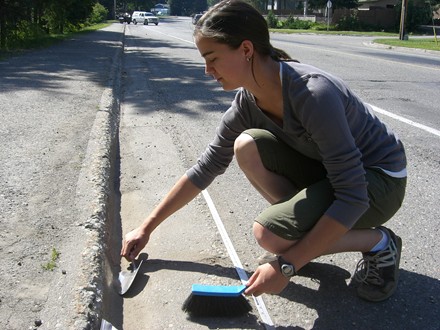Dust Study Underway in Prince George
By 250 News
Saturday, July 25, 2009 06:59 AM

UNBC Environmental Sciences Masters Degree Student Katrina Caley, scoops up some dust from Highland Drive in Prince George
Prince George, B.C.- A special type of street sweeping is taking place in Prince George.
University of Northern B.C. Environmental Sciences Associate Professor, Phil Owens and Masters Degree student Katrina Caley have been gathering samples of road dust.
They mark off a 2 meter square sample site, then carefully sweep the fine dust into a sample bag. In the case of this site, that 2 meter square area produced 2kgs of dust.

(at right, Associate Professor Phil Owens fills a bag with dust from the 2meter sq sample site)
“We have 75 grids in the city and will be taking 4 samples from each grid” says Caley. Those hundreds of samples will then be shipped to Ontario for chemical analysis and then off to the UK for chemical analysis. The final report will not only reveal what kinds of chemicals are in the road dust in the City, it will also show differences in chemical concentrations in different parts of the City.
Professor Owens says the information gathered from this study will help in other urban environmental studies already underway “Ultimately this is the dust that gets into the air here. When it rains, it is washed down the storm sewer into the rivers, so it’s all connected.”
He says it will take about a year for the chemical analysis to be complete.
The study is being conducted in conjunction with Environment Canada and with a study underway in Manchester England.
Previous Story - Next Story
Return to Home










just go down the bypass